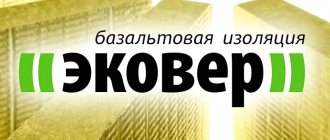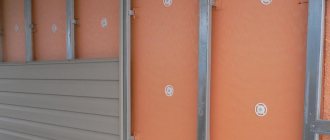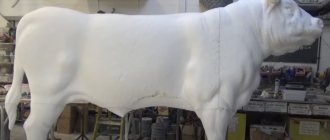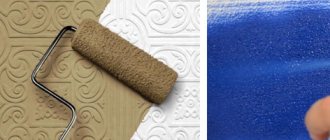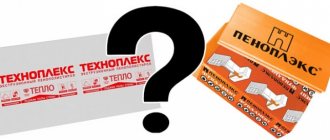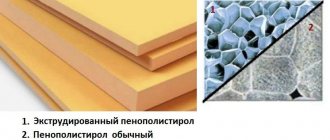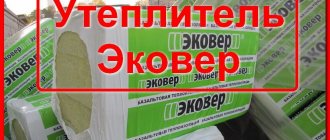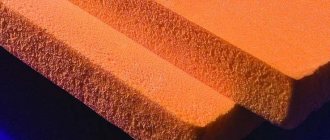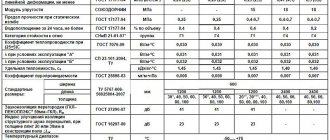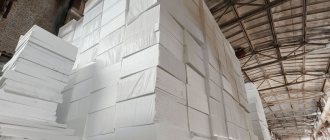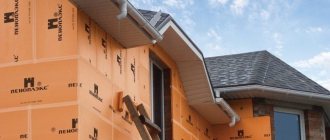Extruded polystyrene foam what is it? - nothing more than some special dense foam. In our century, this synthetic thermal insulation material, most often orange in color, has rapidly gained universal popularity.
Developed in the distant 50s of the last century in America, extruded polystyrene foam has found wide application as thermal insulation of foundations and plinths, and there is probably not enough paper to list all the places where this bright modern material can be laid.
The material is produced using a perfect method of foaming polymer compositions during the extrusion process. This is why we can hear the name of the material as extruded polystyrene foam. After pressing the material through a special high-strength mold, a very strong, reliable material with almost unique thermal insulation properties is obtained.
Before it was discovered that freon gas had a destructive effect on the planet's ozone layer, it was used as a foaming agent.
Since the current 21st century, the so-called “Freon-free” method of manufacturing thermal insulation material has been used all over the world.
Extruded polystyrene foam, or rather the technical characteristics it has, are not the same and differ depending on the manufacturer. The most popular brands on the Russian market are those with the largest sales volume:
- Penoplex;
- Technoplex;
- TechnoNIKOL;
- Ursa.
General information
Extruded polystyrene foam (EPS) is an invention of the recent past. In the middle of the last century, American specialists developed an improved synthetic thermal insulation material based on foam plastic, already known here. Construction companies and ordinary people who wanted to insulate their house for the winter quickly appreciated all the advantages of the new super insulation, thanks to which it quickly overtook other materials for insulating rooms in popularity.
These days, extruded polystyrene foam has virtually no competitors in the field of thermal insulation. Thanks to its unique structure, EPS is much stronger than its competitors, it is resistant to deformation and does not deteriorate during long-term storage. We can say that this material is able to cope with unique insulation tasks. It is not for nothing that in the modern market such a product is more in demand than polystyrene foam or polyurethane foam.
How to choose the right seamless ceiling tiles
A beautiful and durable ceiling can only be achieved with the right choice of finishing method. Seamless tiles for the ceiling in this case are no exception, therefore, it is necessary to choose high quality material.
The first thing you need to pay attention to when choosing ceiling tiles for a room is the back surface of the material. There should be no depressions or swellings on it, which indicate a violation of the technological process. Such material may have many hidden defects, which are most often revealed during operation or installation.
Production of extruded polystyrene foam
Expanded polystyrene is made from the same material as polystyrene foam, that is, from foamed plastics. The only difference between EPPS is its foaming technology.
For its production, a special machine is used - an extruder. Polystyrene granules loaded into the extruder hopper are mixed at high temperature, after which foaming components are added to them, and the foamed orange mass begins to be squeezed out under pressure.
Cooled and cut into plates, the orange material, consisting of tiny balls filled with air, becomes the polystyrene foam that each of us can purchase in the store.
The unique foam structure of the material ensures its high thermal insulation properties. How could it be otherwise, if heat transfer occurs exclusively inside the cell with air, while heat transfer from cell to cell is weak due to their small thickness. Moreover, thin and weakly elastic partitions do not transmit sound vibrations well, which determines the high soundproofing properties of this material.
Water absorption PIR and XPS
It is not difficult to guess that the situation is similar in terms of waterproofing. The water vapor diffusion resistance coefficient (μ) of polyisocyanurate averages 30–70, while the same average for extruded polystyrene is already 80–250. The reason is still the same: the voids of the PIR board perfectly conduct moisture in both directions, and while this is good for vapor barrier, it is bad for waterproofing. By the way, the higher the coefficient of resistance to water vapor diffusion, the higher the thermal insulation properties, which means that extruded polystyrene becomes the winner in this category.
Advantages
To understand for what qualities buyers choose expanded polystyrene, let’s consider the advantages of this thermal insulation material over other insulation materials.
— High thermal insulation properties
In its ability to retain heat, extruded polystyrene foam is superior to almost all known insulation materials, with the exception of polyurethane foam. Its thermal conductivity coefficient is 0.03 W/m*C. This is less than foam, mineral wool and other insulation materials. Only polyurethane foam, for which this indicator is 0.025 W/m*C, can compete with EPPS in the field of heat preservation.
To imagine how high the thermal insulation properties of this material are, it is enough to say that a 30 mm sheet of extruded polystyrene foam retains heat as effectively as 40 mm thick polystyrene foam, 180 mm thick wooden beams, 560 mm thick brickwork or a 1300 mm thick concrete wall!
— Lightness and subtlety
A huge advantage of expanded polystyrene is its lightness. Naturally, it depends on the density of the material, which can be different. So, for example, the density of polystyrene foam brand PSB-S-15 is 10-15 kg/m3. This means that one cubic meter of such insulation weighs only 10-15 kilograms.
The lightness of the material gives an obvious advantage when carrying out construction work. It is convenient to serve such material at a height, and one person can attach it to the wall. And the speed of working with lightweight insulation, especially that produced in the form of slabs, is incomparable with laying mineral wool and other insulation materials.
Add to this the fact that polystyrene foam is an extremely thin insulating material, which only increases its attractiveness in the eyes of the buyer.
— High strength
Despite all the lightness and thinness of the insulation in question, it boasts high mechanical strength. Depending on the density of the produced polystyrene foam, its strength can vary from 25 to 70 MPa. Thus, an EPS board can withstand from 25 to 70 kilograms per 1 meter.
Such high strength allows the use of polystyrene foam as a protective covering for the house, as well as as an underlying layer for floor coverings.
— Low moisture absorption
A valuable quality of this insulation is its ability to resist moisture absorption. This indicator of polystyrene foam does not exceed 0.2%, which means that such material will not get wet even if completely immersed in water. Naturally, it reliably protects the house from moisture penetration.
— Ecological cleanliness
Expanded polystyrene is a synthetic material, but it is absolutely safe for the human body. The environmental friendliness of EPS is evidenced by the fact that children's toys, disposable tableware, protective cases for electronic equipment, etc. are made from this material.
— Durability
Manufacturers claim that extruded polystyrene foam does not change its characteristics even after 50 years of operation. These words can be completely trusted, given that today the material, which has served for 30 years or more, has not lost even 1% of its performance qualities.
— Resistance to critical temperatures
Tests of expanded polystyrene have shown that such a thermal insulation material can withstand temperatures from +75°C to -50°C. Such qualities make it possible to use this heat insulator for insulating houses and structures in the Far North.
— Ability to withstand harmful environmental influences
Expanded polystyrene is resistant to rain and fog, it reliably protects the house from the wind, and fungus and mold do not appear on it. Moreover, such insulation is not of interest to rodents, and therefore, when insulating a house, there is no need to fear that mice will take up residence in the polystyrene foam. True, if they wish, small rodents can easily gnaw a hole in this insulation and enter the house.
Fire resistance PIR and XPS
Here the picture changes to the exact opposite. Extruded polystyrene begins to soften already at 73 degrees Celsius, melts and flows at one hundred degrees, and burns at 360 degrees, generously releasing toxic fumes into the air. The PIR board is covered on both sides with a special coating, which, when a fire occurs, forms a dense carbon crust on the surface and does not allow the flame to pass further. In order to understand which is better, just look at the level of flammability: for extruded polystyrene it is low G3-G4, while the PIR board is practically non-flammable G1. The winner is the PIR board.
Flaws
This heat insulator also has some disadvantages. You should also pay attention to them before purchasing.
- High price
If we compare polystyrene foam with other insulation materials, many buyers are put off by its high cost. However, it is formed, among other things, from the advantages of this material, and therefore the purchase of EPS is justified in the long term.
— Destruction from ultraviolet radiation
Expanded polystyrene loses its properties when exposed to direct sunlight for a long time. Therefore, this insulation must be hidden from ultraviolet radiation behind the façade covering.
— Highly flammable
The flammability class of this material is G3-G4. This suggests that, under the influence of an open flame, polystyrene foam begins to burn strongly, but what is even more dangerous, it emits acrid smoke containing toxic substances. We can say that in a state of combustion this material poses a threat to human health.
— Low vapor permeability
Among other things, this material has low vapor permeability, which is good when insulating a bathhouse or sauna, but not very good when insulating a living space. The fact is that by preventing air from entering the room, such insulation will create a “thermos” effect in the house. As a result, to restore a normal microclimate, you will have to ventilate the room more often.
— Destruction from solvents
Under the influence of solvents, the material begins to deform and collapse. This is especially true for solvents contained in bitumen mastics. Therefore, when insulating a house, you should make sure that the EPS is not exposed to aggressive chemicals.
In addition, polystyrene foam can deteriorate when in contact with certain adhesives. Adhesive based on a synthetic solvent will most likely cause the insulation board to shrink, or even soften it altogether.
Choosing adhesive composition for tiles
The durability and attractive appearance of the ceiling space largely depends on the quality of the adhesive composition. It is the glue that affects the ability of the tile elements to adhere to the surface when exposed to high temperatures or high humidity.
When choosing adhesive for seamless ceiling tiles, you should consider the following points:
- The adhesive should not contain solvents that could damage the structure of polystyrene foam. Such adhesive compositions do not always meet the environmental and sanitary requirements applicable to closed premises. It is best to give preference to water-based formulations.
- The main characteristic of tile adhesive is its high degree of adhesion. The composition must ensure proper adhesion of the finishing material and the working surface, regardless of its type.
- The density of the adhesive composition is also of great importance when finishing the ceiling with ceiling tiles. Using thick glue will allow you to securely fasten the elements to the ceiling, preventing them from sliding in different directions. If the consistency of the glue is not thick enough, then first apply the composition to the tile, wait until it dries a little, and then glue the tile to the ceiling.
- At the same time, the glue should not dry quickly so that it is possible to correctly position the tiles on the ceiling.
- Special adhesive compositions have been developed for seamless ceiling tiles made of expanded polystyrene.
Scope of application of extruded polystyrene foam
Eps is a versatile material that is used for a variety of purposes.
— First of all, expanded polystyrene is an excellent insulation material for private housing construction. It is used to insulate the walls of houses (usually inside the house), floors, roofs and even basements characterized by high humidity. By the way, EPS is one of the best insulation materials for concrete floors at home. Experience has shown that this heat insulator is the material of choice when installing “warm” floors.
In private households, extruded polystyrene foam is used to insulate the blind area of a house; it is used to wrap concrete rings of wells to protect them from freezing, as well as any utility lines. To protect pipes, polystyrene foam is produced in the form of a cylinder, shell and other configurations.
— In industrial and municipal construction, polystyrene foam is widely used for insulation of industrial buildings and structures, multi-storey buildings and main lines.
— This material is also used in agriculture for insulation of farms, greenhouses and large vegetable stores.
— Expanded polystyrene is often used for the construction of roads and runways.
— The insulation in question is actively used in the manufacture of industrial refrigeration units and refrigerators.
PIR and XPS adhesion
The molecular structure of polyisocyanurate gives it an incredibly high level of adhesion, allowing it to “stick” to any surface. For extruded polystyrene, things are somewhat worse - however, the question remains how relevant it is to install insulation using glue. However, where extruded polystyrene cannot cope with all its desire (for example, when installing a “wet facade”), the PIR board will come to the rescue with its excellent ability to attach even to a wet surface of the plaster mortar. The winner in this category is the PIR .
Where polystyrene foam is not used
1. Extruded polystyrene foam is rarely used to insulate the external walls of houses. The point here is the low vapor permeability rate, which creates a risk of the walls inside the structure getting wet. In addition, it is difficult for expanded polystyrene to compete with polystyrene foam in cost, which is why buyers often choose a cheaper material, albeit with weaker characteristics.
2. Do not cover wooden walls with this heat insulator. Due to low vapor exchange, the tree begins to rot and then rot. If polystyrene foam is used to insulate internal walls in a room, it is additionally covered with a layer of mortar to reduce the fire hazard.
Foam snowflakes
In addition to large foam products, you can also make small ones for home. We'll show you step by step how to make neat snowflakes.
We look on the Internet for any template we like for a snowflake. We print it out and cut it out of paper, immediately printing the size that we want to eventually get from foam plastic. The resulting cut out outline is transferred to the foam using a pencil.
Then, carefully using both a utility knife and scissors, the excess pieces of foam are trimmed off to create a snowflake. Excess residues are immediately thrown away so as not to interfere with further work. The finished snowflake remains to be decorated. To do this, coat it all with glue and sprinkle generously with salt. Do this first on one side, then leave it to dry, and on the other.
Related article: DIY toy gun
The finished snowflake will shimmer very beautifully in the light.
You can decorate rooms with such crafts, but do not forget that they are quite fragile. And it is very easy to break such a spectacular decoration. But at the same time, such a snowflake is much stronger than an ordinary paper one, and looks better.
Polystyrene foam insulation technology
In order for the material in question to delight you with warmth in your home, it is important not only to choose the appropriate polystyrene foam, but also to lay it correctly. Depending on the surface to be insulated, the technology may differ.
- Laying on a dirt floor
Very often, expanded polystyrene is used as floor insulation, laying sheets of thermal insulation on the ground to lay laminate, parquet or ceramic tiles on top.
To form the floor, a layer of crushed stone or gravel 30-40 cm thick is laid on the compacted soil. A layer of river sand 10 cm thick is laid on top, which is also leveled and compacted. The sand is covered on top with EPS sheets with a stepped edge along the edges. The joints are taped with tape. Expanded polystyrene for floor insulation should have increased strength, and its thickness should vary from 50 to 100 mm. A waterproofing material is laid on top of the EPS, over which a reinforced cement-sand screed is made.
Important! If polystyrene foam is laid in a room with increased mechanical loads on the floor, a concrete screed should be poured under the heat insulator.
- Insulation of concrete floor
It is even easier to lay polystyrene foam on a concrete floor. The main thing is that the base is level. If there are cracks and other damage on such a surface, it is better to pour a sand-cement screed on top, then lay EPS sheets and cover everything with waterproofing. And another screed should be placed on top of the waterproofing.
Important! Expanded polystyrene boards can be laid not only in rooms, but also on the balcony. Please note that such work in an unglazed room is carried out at air temperatures exceeding 5°C.
- Roof insulation
Modern technologies make it possible to efficiently insulate not only walls and floors, but also the roof. It is only important to know some of the nuances of such thermal insulation.
Insulation work should begin when you already have a sheathing, on top of which the roof itself is laid (slate, metal tiles, ondulin, etc.). On the inside of the sheathing, a vapor barrier film should be filled, on top of which expanded polystyrene slabs are laid over the entire roof area. Considering the size of the slabs is 600x1200 mm, they must be tightly inserted between the rafters.
A waterproofing film is laid on the inner surface of the roof over polystyrene foam. It is fixed at the top with internal lathing, and then sheathed with finishing material (plasterboard, board, clapboard, etc.).
- Foundation insulation
In some cases, polystyrene foam is used if necessary to insulate the foundation. At the same time, you can insulate both the foundation of a building under construction and a long-lived house.
First of all, the foundation should be cleaned of dirt, dust and oils. If there are remains of waterproofing on top, these should also be removed. After preparing the surface, you need to apply a waterproofing mixture to it. It is only important that it does not contain bitumen, which can destroy polystyrene foam.
The best heat insulator for such insulation would be polystyrene foam with a density of 35 kg/m2. and higher. To attach EPS boards to the foundation, special adhesive for polystyrene foam is used. After applying the glue, you should wait one minute, then press the insulation onto it, hold it for a minute and begin installing the next slab.
Important! If it is necessary to install a thick layer of polystyrene foam, you can glue one slab on top of another. In this case, it is important that the top layer overlaps the joint of the bottom one. By the way, after the glue has dried, it is additionally recommended to fix the slabs with dowel umbrellas. It is enough to install 6 such fasteners on a sheet.
The top layer of insulation should be covered with reinforcing mesh and sand-cement screed with waterproofing. As an option, the insulation is covered with false panels on top.
- Insulation of internal walls
Extruded polystyrene foam is very often used to insulate walls inside the house. To do this, the walls must first be cleaned of the previous coating and paint materials. After this, they need to be leveled so that the EPS slabs lay flat, without distortion (brick walls need to be plastered).
First, acrylic primer should be applied to the wall, which will not only improve adhesion, but also become a thin leveling layer. Before laying polystyrene foam, the primer must dry for 24 hours. After this, you can mount the slabs to the wall using a special adhesive. The glue is applied to the wall with a roller or brush, and after a minute the EPS sheet is fixed onto it.
It is recommended to start installing polystyrene foam from one of the corners, laying the insulation from bottom to top. If necessary, the slabs should be cut to size. This can be done using a serrated hacksaw or a hot string. As in the case of foundation insulation, the panels, in addition to glue, need to be fixed with dowels.
The joints between the panels should be sealed with foam. A fiberglass mesh, a layer of waterproofing and a layer of plaster are applied on top of such insulation.
- Facade insulation
We have already said that polystyrene foam is rarely used for facades. However, if there is a need to use such insulation, carry out the work as follows:
Clean the wall from paint and other finishing coatings, remove all kinds of irregularities. As with the previous surfaces, apply special glue to the wall, then glue the EPS board to it. After the glue has dried, additionally secure the insulation with dowel umbrellas.
A reinforcing mesh is laid on top of the polystyrene foam, again using an adhesive solution. After it has dried, the surface is primed and façade material, for example, clinker brick, is laid.
Remember that facade insulation should be carried out in the warm season, when humidity is low, because in this case the materials easily adhere to each other.
Step-by-step technique for gluing to the ceiling
In order for the job to be done well, you need to follow a step-by-step algorithm of actions. This way you will eliminate mistakes in the repair process and significantly speed it up.
Preparing the surface: cleaning and marking
Foam ceiling tiles should be glued only after all preparatory work. The package of tiles should be opened three or four hours in advance so that they can absorb the humidity and temperature of the room.
The old coating is removed if it crumbles and falls off. Be sure to wash off the whitewash on which the slabs will not hold. If the previous material is in good condition, then it can be left. All cracks are puttied, and irregularities are rubbed down.
Before gluing, the ceiling is primed with a roller. This will create a strong bond between the two surfaces. Allow approximately four hours for the primer to dry.
To make the correct markup:
- Determine the exact center of the ceiling. To do this, draw diagonals from the corners of the room across the entire ceiling.
- We mark the middle on all walls, and stretch a thread between parallel walls, connecting the marks to each other. At the same time, the thread should also come into contact with the middle point.
- If the walls are of different lengths and the thread moves, the master must make corrections.
- Lines are drawn with a pencil along the stretched threads to guide them during repairs.
Materials and tools
To secure the polystyrene foam ceiling tiles in place, prepare the following tools:
- painter's cord to mark;
- scissors or knife for installation;
- spatula and putty;
- primer and roller for applying it;
- pencil, tape measure and thread;
- brush or glue gun;
- rags for cleaning off excess composition.
Installation algorithm
The slab can be glued in rows, evenly or with shifts, parallel or in a diagonal direction from one corner to another. The adhesive for installing ceiling tiles is distributed in strips with a gap of about one and a half centimeters. Visual instructions in the video:
The first slab is placed on the ceiling in any of the corners. It is pressed up and held until the glue has time to set. If glue appears around the edges, carefully wipe it off with a rag. The second tile is glued end-to-end to the first, repeating the same algorithm.
In the center you need to cut a hole for the chandelier. Joints that may remain visible are sealed with acrylic sealants. The ceiling takes about a day to dry. Afterwards it can be coated with water-based or acrylic paint.
Popular polystyrene foam manufacturers
The building materials market boasts expanded polystyrene from a variety of manufacturers, both foreign and domestic. Let's get acquainted with the most popular brands.
• Europlex . This company is a leader in the production of thermal insulation for the construction industry. Among Europlex products you can find both stepped and corrugated slabs with a wide variety of physical properties that can satisfy the requirements of the most demanding customer.
• "URSA XPS" . The material from this company is characterized by increased strength, which makes it indispensable for professional construction. If you need polystyrene foam for floor insulation that can withstand increased loads, slabs from URSA are your best choice!
• "Penoplex". This is the largest Russian manufacturer of expanded polystyrene, which produces insulation for both private and industrial buildings, as well as for various utilities. Manufacturers can boast of a variety of forms and types of polystyrene foam at affordable prices, which distinguishes this company from many other manufacturers.
• Stirex. Another Russian manufacturer producing panels for both civil and industrial construction. Styrex cannot boast such a wide range of products as Europlex, but this company produces panels for aviation and road construction. In addition, the company in question pleasantly surprises with its prices.
As you can see, extruded polystyrene foam is a universal material that can become a reliable protection for your home from cold, excess noise and other troubles. With such insulation, installed in compliance with the technology, your home will forget about all the problems for decades!
Polyurethane foam: types, properties, application
Ecowool - properties, application methods, manufacturers
Weight of PIR and XPS boards
The “airiness” of the PIR board makes it much lighter in weight compared to other types of insulation and especially dense polystyrene. The PIR board is the best option for cladding roofs, plaster facades and pitched roofs - all those structures that are critical to excess load. In addition, the high fire resistance class of the PIR board makes it possible not to create fire protection belts from corrugated sheets, which are mandatory for extruded polystyrene, which is another way to reduce the overall weight of the insulation. The winner in this category is the PIR .
